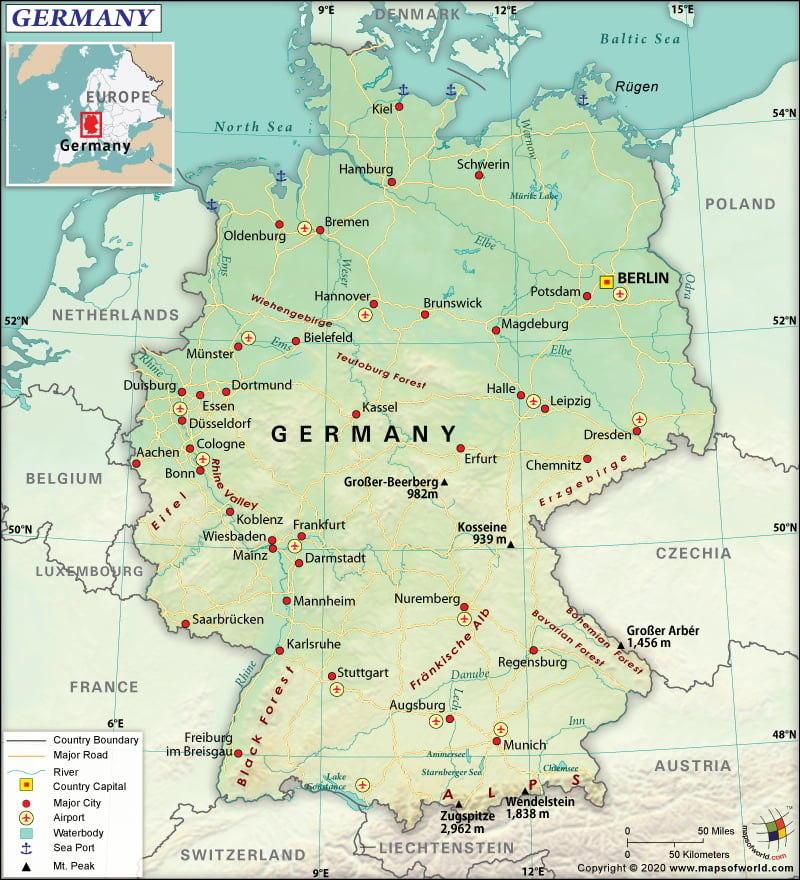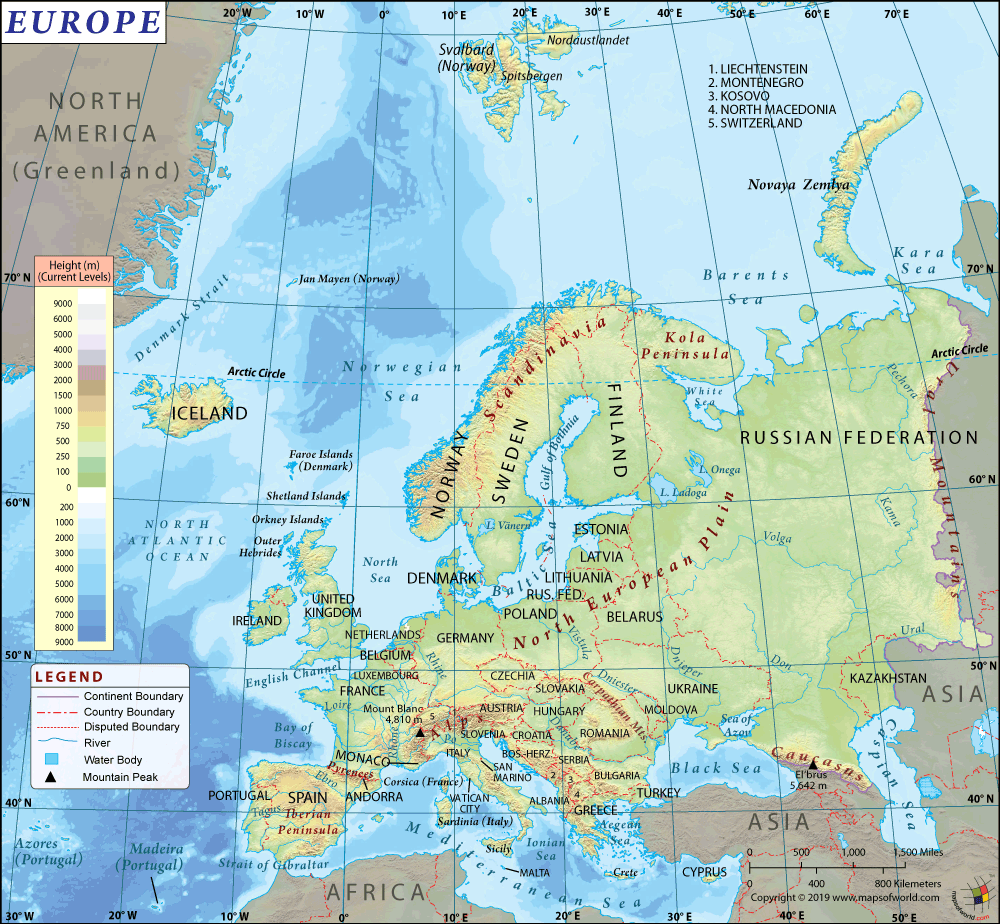What are the Key Facts of Germany?

|
Official Name |
Federal Republic of Germany |
|
Continent |
Europe |
|
Capital |
Berlin |
|
Largest City |
Berlin |
|
Coordinates |
51.000000, 9.000000 |
|
Area |
137,988 sq. mi ( 357,386 sq. km) |
|
Land Boundaries |
2,308 mi ( 3,714 km) |
|
Coastline |
1,484 mi ( 2,389 km) |
|
Currency |
Euro (€) (EUR) |
|
Neighboring Countries |
Austria, Switzerland, France, Luxembourg, Belgium, Netherlands, Denmark, Poland, Czechia |
|
Population |
83,019,200 (2018 est. ) |
|
Official Languages |
German |
|
Major Religion |
Christianity |
|
National Day |
3 October (German Unity Day) |
|
National Anthem |
“Das Lied der Deutschen” |
|
Form of Government |
Federal parliamentary republic |
|
President |
Frank-Walter Steinmeier |
|
Chancellor |
Angela Merkel |
|
GDP per capita (PPP) |
$ 53,735.2 (World Bank, 2018) |
|
GDP per capita (nominal) |
$ 48,195.6 (World Bank, 2018) |
|
HDI |
0.936 (2017), Rank: 5 |
|
Literacy Rate (%) |
NA |
|
Space Agency |
DLR Space Administration |
|
Military Expenditure Ranking |
8 (SIPRI, 2017) |
|
No. of Olympic Medals |
855 (as of 2018) |
|
Driving Side |
right |
|
Calling Code |
+49 |
|
Time Zone |
UTC+1 (CET), Summer (DST) UTC+2 (CEST) |
|
Internet TLD |
.de |
Where is Germany?
Germany is a Central European country that is located between Poland and the Netherlands. It borders both the North Sea and the Baltic Sea and is situated to the south of Denmark.
Germany’s Flag
The German flag features three equal horizontal stripes of black, red, and gold from top to bottom. The German flag has an aspect ratio of 3:5.
Black and gold were the colors of the Holy Roman Emperor’s flag in around the tenth century, which featured an eagle that later included red accents.
What is the Geography of Germany?
Germany is spread across a total area of 357,386 sq. km (137,988 sq. mi), out of which 348,672 sq. km (134,623 sq. mi) land area and 8,350 sq. km (3,224 sq. mi) is water area. It has a 3,714 km (2,308 mi) long land boundary and a coastline that is 2,389 km (1,484 mi) long. In terms of size, Germany is the 7th largest European country.
Germany shares its borders with 9 neighbouring countries including Austria (801 km or 498 mi), the Czech Republic (704 km or 437 mi), Netherlands (575 km or 357 mi), Poland (467 km or 290 mi), France (418 km or 260 mi), Switzerland (348 km or 216 mi), Denmark (140 km or 87 mi), Belgium (133 km or 83 mi), and Luxembourg (128 km or 80 mi).
The terrain in Germany is characterized by Bavarian Alps in the south, uplands in the centre, and lowlands in the north. While Zugspitze is the highest elevation point of the country at 2,963 m (9,721 ft), Neuendorf bei Wilster is the lowest elevation point at -3.5 m (-11.5 ft). The mean elevation of Germany is 263 m (863 ft).
The landscape in Germany rises steadily from the north to the south. While the far northern regions have below-sea-level marshlands, the southernmost regions have rugged and snow-capped Alps. Germany has a diverse landform along with numerous freshwater bodies.
The major mountains in Germany are Zugspitze, Schneefernerkopf, Wetterspitze, Hochwanner, Hollentalspitze, and many more. The longest river in the country is the Danube. Other major rivers are Rhine, Elbe, Main, Moselle, Oder, etc. Major lakes in Germany include Constance, Muritz, Mecklenburg Lakeland, Chiemsee, Starnberg, Ammersee, Steinhuder Meer, Titisee, Eibsee, etc.
The northern parts of Germany consist of the Northern European Plain. Many rivers, bogs, and streams dissect this flat, lowland terrain, making it perfect for farming. Germany’s coastline along the North Sea consists of low and marshy wetlands having dikes, scattered islands, and mudflats. The landform along the Baltic Sea is hillier. However, some jagged cliffs are also found.
The largest island of the country is Rugen. It is hilly and is completely covered by forests. There are cliffs as well as sandy beaches in Rugen.
The northeastern part, stretching to the south of Berlin, consists of sandy land. Dozens of small lakes punctuate this sandy land. The central part of Germany mainly consists of forested uplands. Harz Mountains (having volcanic origin), as well as Rothaargebirge Mountains (mostly thickly wooded), are the major landforms here.
The southern part of Germany mainly has rounded hills and mountains. The Eifel and Huynsruck uplands are located in the front of the Rhine River Valley. The dominant land features towards the southeast are the Vogelsberg Mountains, Thuringian Forest, and the Rhon Plateau. The uplands continue rising towards the east and ultimately rises into the Ore Mountains along the border of the Czech Republic.
Heavily forested hills are the main landforms in the farther southern parts of Germany. While the Bohemian Forest covers the lower mountain range that is located along the border of the Czech Republic, the thick, Black Forest is situated in the far southwestern border with France where Rhine River flows.
The Bavarian Alps is located along the Austrian border in the south. The highest elevation point of the country is also located in the Bavarian Alps and it remains covered by snow.
The Frisian Islands (East and north remain separated from one another) stretches along the northern coastline of Germany. The Waddenmeer separates these islands from mainland Germany. In fact, a small level of protection is also provided by these barrier islands from the North Sea.
Germany has a moderate climate. No long period of hot/cold weather is present in Germany. The climate in both the coastal and northwestern parts of the country is influenced by warm summers as well as mild cloudy winters.
In most parts of the North Sea coast, the midwinter temperature remains around 1.5 °C (34.7 °F) or higher. The climate becomes continental as you move farther inland. The temperature variation becomes higher in these areas. The winters are colder and the summers are warmer.
January is the coldest month of the year. While the average temperature in the north revolves around 1.5 °C (34.7 °F), it remains around -2 °C (28.4 °F) in the southern regions.
July is the warmest month of the year. While the average temperature in the northern coastal areas remains within 16-18 °C (60.8-64.4 °F), it remains around 20 °C (68 °F) in the southern regions.
Mountain climate prevails in the Alpine regions in the extreme southern regions. It is characterized by lower temperatures and more rainfall due to higher altitudes. “Föhn” or warm wind is an occasional atmospheric condition. These winds can get stronger sometimes, causing damage in late autumn/winter.
Strong Atlantic low-pressure systems can cause uncomfortable weather and gales with heavy rain/thunderstorms/showers in the western coastal areas as well as in the mountainous areas during fall or winter.
Showery weather becomes prevalent in the weaker low-pressure systems during summertime. In fact, it also leads to severe thunderstorms sometimes. In Germany, the winter season generally remains mild. However, the temperature can reach far below zero and may get heavy snowfall mainly in the mountainous/southern/eastern regions.
What is the Economy of Germany?
Germany has a highly developed, social market economy. In terms of nominal GDP, it is one of the top-5 largest economies. Germany’s nominal GDP grew at a rate of 1.5% in 2018 to reach US$ 3,951,340 million. The growth rate has come down from 2.5% in 2017 to 1.5% in 2018.
The economy of Germany is slowing down significantly. Its central bank, Bundesbank, has said in its latest monthly report that after contracting by 0.1% during April-June 2019, the “economic output could have decreased slightly in the third quarter of 2019.” Reports say Brexit and trade war has adversely affected the German economy, slowing down exports significantly.
The major export items of the economy are cars, vehicular parts, packaged medicaments, spacecraft, helicopters, planes, human/animal blood, etc. The major items imported by Germany are crude petroleum, cars, vehicular parts, packaged medicaments, human/animal blood, etc. In 2017, the economy exported US$1.33 trillion worth of goods and imported $1.08 trillion worth of items, thereby leading to a positive balance of trade of US$251 billion.
The unemployment rate in Germany was 3.4% in 2018. Despite low unemployment, millions of people don’t have enough money to either adequately heat their homes or pay their bills. Germany’s Federal Statistics Office has found out that almost 1 in 5 people in the country were threatened by poverty in 2017. Citing data from a European Union study, it has said that 19% of the population (around 15.5 million people) are threatened by poverty.
What is the Transportation System of Germany?
Germany has 625,000 km (388,357 mi) long roadways and all of them are paved including the local roads. Around 12,996 km (8,075 mi) of expressways are there in the country.
Germany has around 7,467 km (4,640 mi) of waterways. Most of the goods are navigated through the Rhine River. The Black Sea and the North Sea are linked by the Main-Danube Canal. Rostock on the Baltic Sea is the major seaport of the country. The major river ports are Bremen, Wilhelmshaven Bremerhaven, Neuss-Dusseldorf, Karlsruhe, Duisburg, Lubeck, Hamburg, and Brunsbuttel.
There is a 33,590 km (20,872 mi) long railway network, out of which 33,331 km (20,711 mi) is a standard gauge railway network and 220 km (137 mi) of narrow gauge network. 19,973 km (12,411 mi) of electrified standard gauge and 79 km (49 mi) of the electrified narrow-gauge railway network is available in Germany.
The air transport system is very developed. There are 539 airports in the country, out of which 318 are paved and 221 unpaved. 23 heliports are also there in the country.
What International Organizations is Germany part of?
UN, WHO, WTO, IMF, Paris Club, G-5, G-7, G-8, G-10, G-20, UNESCO, Australia Group, Schengen Convention, BIS, CBSS, CD, CDB, CE, CERN, EAPC, EBRD, ECB, EIB, EMU, ESA, EU, FAO, FATF, IADB, IAEA, IBRD, ICAO, ICCt, ICRM, IDA, IEA, IFAD, IFC, IFRCS, IHO, ILO, IMO, IMSO, Interpol, IOC, IOM, IPU, ISO, ITSO, ITU, MIGA, MINURSO, MINUSMA, NATO, NEA, NSG, OECD, OPCW, OSCE, PCA, UNAMID, UNCTAD, UNHCR, UNIDO, UNIFIL, UNMISS, UNRWA, UNWTO, UPU, WCO, WIPO, WMO, ZC, ADB (nonregional member), AfDB (nonregional member), Arctic Council (observer), BSEC (observer), EITI (implementing country), ICC (national committees), IGAD (partners), ITUC (NGOs), OAS (observer), Pacific Alliance (observer), SELEC (observer), SICA (observer)
Related Links:

